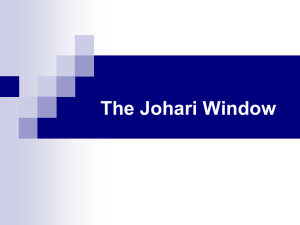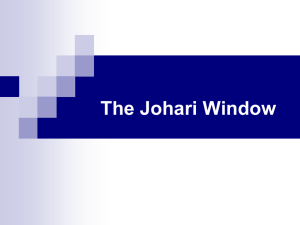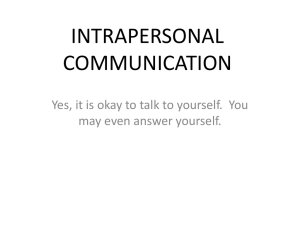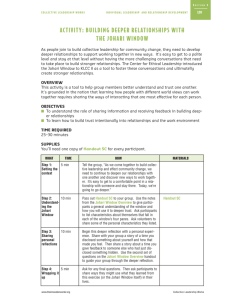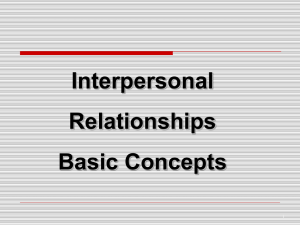to johari window model
advertisement
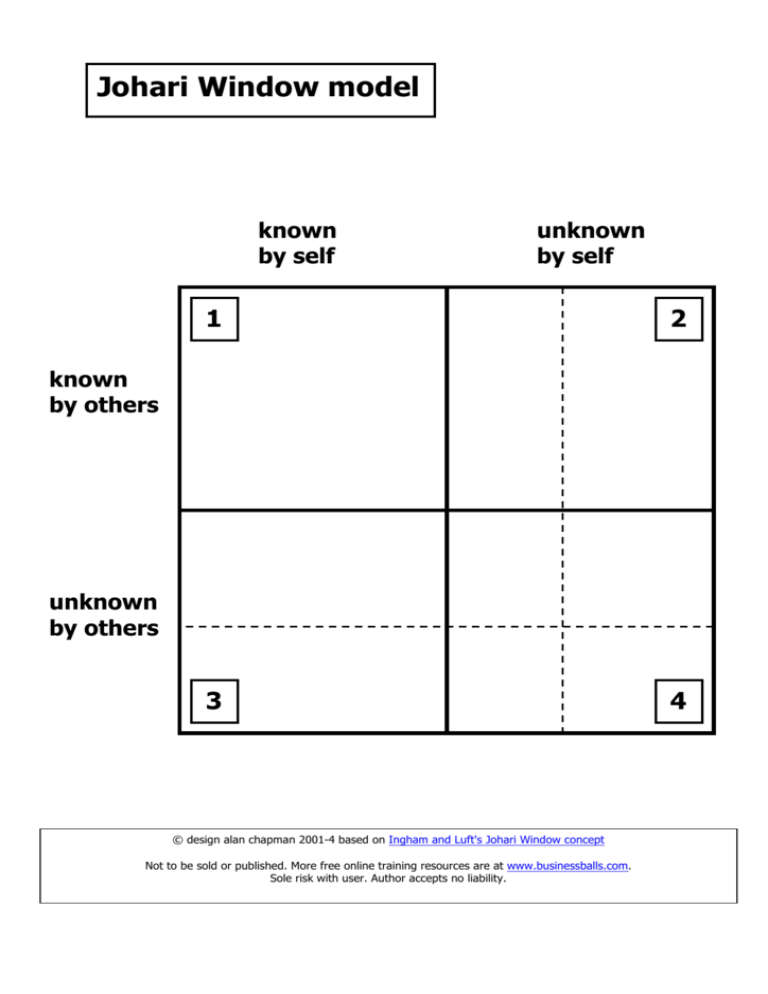
Johari Window model
known
by self
unknown
by self
1
2
3
4
known
by others
unknown
by others
© design alan chapman 2001-4 based on Ingham and Luft's Johari Window concept
Not to be sold or published. More free online training resources are at www.businessballs.com.
Sole risk with user. Author accepts no liability.
SOME USEFUL INFORMATION ON THE JOHARI WINDOW
The use of this material is free, provided that copyright (Alan Chapman 1995-2006 adaptation,
review and code based on Ingham and Luft's original johari window concept) is acknowledged
and reference is made to the www.businessballs.com website. This material may not be sold, or
published in any form. Disclaimer: Reliance on information, material, advice, or other linked or
recommended resources, received from Alan Chapman, shall be at your sole risk, and Alan
Chapman assumes no responsibility for any errors, omissions, or damages arising. Users of this
website are encouraged to confirm information received with other sources, and to seek local
qualified advice if embarking on any actions that could carry personal or organisational liabilities.
Managing people and relationships are sensitive activities; the free material and advice available
via this website do not provide all necessary safeguards and checks. Please retain this notice on
all copies.
Background
The Johari Window model was developed by American psychologists Joseph
Luft and Harry Ingham in the 1950's, while researching group dynamics (hence
the title, from their first names, Joseph and Harry). The Johari Window soon
became a widely used model for understanding and training self-awareness,
personal development, improving communications, interpersonal relationships,
group dynamics, team development and inter-group relationships.
The Johari Window model is also referred to as a 'disclosure/feedback model of
self awareness', and by some people an 'information processing tool'. The Johari
Window actually represents information - feelings, experience, views, attitudes,
skills, intentions, motivation, etc - within or about a person - in relation to their
group, from four perspectives, which are described below. The Johari Window
model can also be used to represent the same information for a group in relation
to other groups. Johari Window terminology refers to 'self' and 'others': 'self'
means oneself, ie, the person subject to the Johari Window analysis. 'Others'
means other people in the person's group or team.
Johari Window Four Regions
The four Johari Window perspectives are called 'regions' or 'areas' or 'quadrants'.
Each of these regions contains and represents the information - feelings,
motivation, etc. - known about the person, in terms of whether the information is
known or unknown by the person, and whether the information is known or
unknown by others in the group. HAND OUT. The Johari Window's four
regions, (areas, quadrants, or perspectives) are ARENA, FACADE,
BLINDSPOT, UNKNOWN.
what is known by the person about him/herself and is also known by others open area, open self, free area, free self, or 'the arena'
what is unknown by the person about him/herself but which others know - blind
area, blind self, or 'blindspot'
what the person knows about him/herself that others do not know - hidden area,
hidden self, avoided area, avoided self or 'facade'
what is unknown by the person about him/herself and is also unknown by others
- unknown area or unknown self.
Johari region 1 is also known as the 'area of free activity'. This is the information
about the person - behaviour, attitude, feelings, emotion, knowledge, experience,
skills, views, etc - known by the person ('the self') and known by the group
('others'). The aim in any group should always be to develop the 'open area' for
every person, because when we work in this area with others we are at our most
effective and productive, and the group is at its most productive too. The open
free area, or 'the arena', can be seen as the space where good communications
and cooperation occur, free from distractions, mistrust, confusion, conflict and
misunderstanding.
Established team members logically tend to have larger open areas than new
team members. New team members start with relatively small open areas
because relatively little knowledge about the new team member is shared. The
size of the open area can be expanded horizontally into the blind space, by
seeking and actively listening to feedback from other group members. This
process is known as 'feedback solicitation'. Also, other group members can help
a team member expand their open area by offering feedback, sensitively of
course. The size of the open area can also be expanded vertically downwards
into the hidden or avoided space by the person's disclosure of information,
feelings, etc about him/herself to the group and group members. Also, group
members can help a person expand their open area into the hidden area by
asking the person about him/herself. Managers and team leaders can play an
important role in facilitating feedback and disclosure among group members,
and in directly giving feedback to individuals about their own blind areas.
Leaders also have a big responsibility to promote a culture and expectation for
open, honest, positive, helpful, constructive, sensitive communications, and the
sharing of knowledge throughout their organization. Top performing groups,
departments, companies and organizations always tend to have a culture of open
positive communication, so encouraging the positive development of the 'open
area' or 'open self' for everyone is a simple yet fundamental aspect of effective
leadership.
Johari region 2 is what is known about a person by others in the group, but is
unknown by the person him/herself. By seeking or soliciting feedback from
1
others, the aim should be to reduce this area and thereby to increase the open
area, ie, to increase self-awareness. This blind area is not an effective or
productive space for individuals or groups. This blind area could also be referred
to as ignorance about oneself, or issues in which one is deluded. A blind area
could also include issues that others are deliberately withholding from a person.
We all know how difficult it is to work well when kept in the dark. No-one
works well when subject to 'mushroom management'. People who are 'thickskinned' tend to have a large 'blind area'.
Group members and managers can take some responsibility for helping an
individual to reduce their blind area - in turn increasing the open area - by giving
sensitive feedback and encouraging disclosure. Managers should promote a
climate of non-judgmental feedback, and group response to individual
disclosure, which reduces fear and therefore encourages both processes to
happen. The extent to which an individual seeks feedback, and the issues on
which feedback is sought, must always be at the individual's own discretion.
Some people are more resilient than others - care needs to be taken to avoid
causing emotional upset.
Johari region 3 is what is known to ourselves but kept hidden from, and
therefore unknown, to others. This hidden or avoided self represents
information, feelings, etc, anything that a person knows about him/self, but
which is not revealed or is kept hidden from others. The hidden area could also
include sensitivities, fears, hidden agendas, manipulative intentions, secrets anything that a person knows but does not reveal, for whatever reason. It's
natural for very personal and private information and feelings to remain hidden,
indeed, certain information, feelings and experiences have no bearing on work,
and so can and should remain hidden. However, typically, a lot of hidden
information is not very personal, it is work- or performance-related, and so is
better positioned in the open area.
Relevant hidden information and feelings, etc, should be moved into the open
area through the process of 'disclosure'. The aim should be to disclose and
expose relevant information and feelings - hence the Johari Window
terminology 'self-disclosure' and 'exposure process', thereby increasing the open
area. By telling others how we feel and other information about ourselves we
reduce the hidden area, and increase the open area, which enables better
understanding, cooperation, trust, team-working effectiveness and productivity.
Reducing hidden areas also reduces the potential for confusion,
misunderstanding, poor communication, etc, which all distract from and
undermine team effectiveness.
Organizational culture and working atmosphere have a major influence on group
members' preparedness to disclose their hidden selves. Most people fear
judgement or vulnerability and therefore hold back hidden information and
feelings, etc, that if moved into the open area, ie known by the group as well,
2
would enhance mutual understanding, and thereby improve group awareness,
enabling better individual performance and group effectiveness.
The extent to which an individual discloses personal feelings and information,
and the issues which are disclosed, and to whom, must always be at the
individual's own discretion. Some people are more keen and able than others to
disclose. People should disclose at a pace and depth that they find personally
comfortable. As with feedback, some people are more resilient than others - care
needs to be taken to avoid causing emotional upset.
Johari region 4 contains information, feelings, latent abilities, aptitudes,
experiences etc, that are unknown to the person him/herself and unknown to
others in the group. These unknown issues take a variety of forms: they can be
feelings, behaviours, attitudes, capabilities, aptitudes, which can be quite close
to the surface, and which can be positive and useful, or they can be deeper
aspects of a person's personality, influencing his/her behaviour to various
degrees. Large unknown areas would typically be expected in younger people,
and people who lack experience or self-belief.
Examples of unknown factors are as follows, and the first example is
particularly relevant and common, especially in typical organizations and teams:
an ability that is under-estimated or un-tried through lack of opportunity,
encouragement, confidence or training
a natural ability or aptitude that a person doesn't realise they possess
a fear or aversion that a person does not know they have
an unknown illness
repressed or subconscious feelings
conditioned behaviour or attitudes from childhood
The processes by which this information and knowledge can be uncovered are
various, and can be prompted through self-discovery or observation by others, or
in certain situations through collective or mutual discovery, of the sort of
discovery experienced on outward bound courses or other deep or intensive
group work. Counselling can also uncover unknown issues, but this would then
be known to the person and by one other, rather than by a group.
Whether unknown 'discovered' knowledge moves into the hidden, blind or open
area depends on who discovers it and what they do with the knowledge, notably
whether it is then given as feedback, or disclosed.
Again as with disclosure and soliciting feedback, the process of self discovery is
a sensitive one. The extent and depth to which an individual is able to seek out
discover their unknown feelings must always be at the individual's own
discretion. Some people are more keen and able than others to do this.
3
Uncovering 'hidden talents' - that is unknown aptitudes and skills, not to be
confused with developing the Johari 'hidden area' - is another aspect of
developing the unknown area, and is not so sensitive as unknown feelings.
Providing people with the opportunity to try new things, with no great pressure
to succeed, is often a useful way to discover unknown abilities, and thereby
reduce the unknown area.
Managers and leaders can help by creating an environment that encourages selfdiscovery, and to promote the processes of self discovery, constructive
observation and feedback among team members. It is a widely accepted
industrial fact that the majority of staff in any organization are at any time
working well within their potential. Creating a culture, climate and expectation
for self-discovery helps people to fulfil more of their potential and thereby to
achieve more, and to contribute more to organizational performance.
A note of caution about Johari region 4: The unknown area could also include
repressed or subconscious feelings rooted in formative events and traumatic past
experiences, which can stay unknown for a lifetime. In a work or organizational
context the Johari Window should not be used to address issues of a clinical
nature.
4
